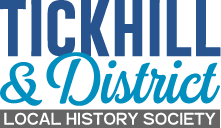

Tickhill’s Fire Brigade
In the 18th and early 19th Centuries people subscribed to fire insurance companies to ensure that help would arrive (eventually) to fight a fire at their properties. A fire insurance plaque fitted to the front of a building indicated to which company the owner belonged. One example of a fire insurance plaque still in place is at 22 Castlegate. The circular plaque has an emblem of three crowns surrounded by the words ‘Notts and Derbys’ representing the Nottinghamshire and Derbyshire Fire Insurance Company.
The vestry Minutes for 12 February 1852 (included here courtesy of Doncaster Archives) tell us when Tickhill obtained its new fire engine to fight a fire anywhere in the local community.
Resolved: that a fire engine having been provided for the use of the Parish – by general subscription – and the same having been this day as by agreement transferred to the Churchwardens for the time being into their custody – that they be now fully authorised to pay yearly any sum not exceeding two guineas as remuneration for Firemen (now eighteen in number) for working and keeping the same in practice.
Edw H Brrohksbank Vicar
The Vestry Minutes for 23 April 1878 noted ‘Mr Rawson presented the accounts of the Fire Engine, showing a balance of £3/118/3 – the accounts were allowed and passed.’ The Minutes made no mention of the fire engine actually being used.

As in the photograph provided courtesy of Mrs Joan Wilcox, a descendant of Mr Rawson, the fire engine was horse drawn and fitted with manual pumps needing up to eight people to operate them. The firemen had no uniforms but eight are shown in the photograph with helmets. The engine carried a tank of water. A photograph on page 76 of Bawtry, Tickhill and Wadworth by Peter Tuffrey shows the Tickhill fire engine in a farmyard being replenished with water from a large barrel. Once the water ran out, the engine would either have to be supplied from a pond, stream or well, or return to the farmyard for refilling. If a fire broke out, the men were summoned from their usual occupations by the tolling of the church bell, a practice which continued up to the 1930s.
In 1946 the Fire force Commander at Sheffield asked if two manual pumps from Tickhill could go to the Sheffield Fire Service Museum. Tickhill Urban District Council agreed to grant this request ‘on loan’. The horse drawn fire engine and another pump are now on display in Doncaster Museum.
With mobilisation of the Auxiliary Fire Service in 1939, Tickhill UDC had to make sure enough equipment was available for the fire fighters. The fire hose was ‘practically unusable’ so in 1940 the Clerk ordered five fifty foot lengths of 2¾ inch hose costing £6/1/- per length. The Council then bought four extending ladders (£2/19/6 each) and 500 four-gallon petrol tins (costing approximately a total of £3/2/6). The Council also purchased overalls, boots and helmets for the Fire Brigade Chief and eight men.

Most of the AFS fire fighters were farm workers, classed as a reserved occupation, and the men were not liable to serve in the armed forces. The Chief of Tickhill Fire Brigade, Mr W Davies, was paid a retaining fee of £5 p.a. while other fire fighters received £1/10/- p.a. Additionally, the men received 2/- for attending fire practice. Pay for attending fires was 2/- per hour in the day time and 3/- per hour at night. The hourly rates for the chief were 3/6 (day time) and 5/- (night time). The photograph on the right provided courtesy of Mrs Linda Mayes shows the Brigade including her father, the late Walter Cannings, second from the right on the middle row. After the War, Tickhill had three retained firemen but in January 1946 their engagement was terminated.
Doncaster Archives has kindly given permission for the following holdings in the archive to be quoted on this website - Tickhill Vestry Minutes of 1852 and 1878 Ref P56/4/A1, Tickhill Urban District Council Minutes 1939-1946 Ref UDTICK/1/9.